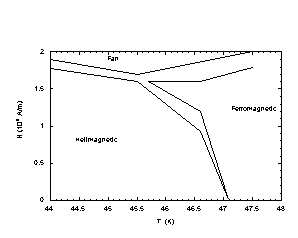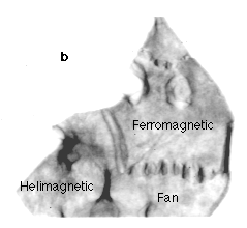

REAL TIME BRAGG DIFFRACTION IMAGING STUDY OF MAGNETIC PHASE TRANSITIONS IN MnP
Etienne Pernot1, Carlos Medrano 2, Elodie Boller 1,3, Frédéric Lorut 1, José Baruchel 1
1 ESRF, BP
220, 38043 Grenoble cedex 9, France,
2 Univ. Zaragoza,
50009, Zaragoza Spain,
3 INSA 20 Av. des
Buttes de Coemes, 35043 Rennes cedex, France
Keywords : Magnetic phase transition, X-ray
imaging, Data acquisition.
Bragg diffraction X-ray imaging (X-ray topography) produces direct-space images of crystal defects, domains, or just thickness variations in single crystals, via the inhomogeneous intensity of the Bragg-diffracted beams. The advent of synchrotron radiation brought high intensity making real-time imaging possible in transmission geometry. On third-generation machines like the ESRF, the small size of the source allows image blurring to remain small even when the detector is placed far (10-100 cm) from the sample. We took advantage of this fact at the long (145m) "X-ray imaging" ID19 beamline of the ESRF.
The present work deals with the 'real time' observation of the various interfaces, including the phase coexistence at the triple point, and their interpretations. We used for that white beam synchrotron radiation diffraction imaging with a FRELON (Fast Readout LOw Noise) 14 bits 1024x1024 pixels, cooled CCD camera, designed and constructed at the ESRF. Software was written in order to allow to record more than 2 images/second with a 10 mm pixel resolution, and exposures times in the range 0.1-0.2 s.
Orthorhombic MnP features,when a field is applied along the intermediate b axis, a magnetic phase diagram with ferromagnetic, helimagnetic, and fan structures, as indicated on fig. 1. Synchrotron radiation topography can reveal the coexistence of two or three of the magnetic phases because each involves slightly different lattice distortions. The way a first order magnetic transition occurs is a function of the competition between several energy terms: magnetostatic, elastic, interface, ... .One of the noteworthy features is that the fan phase nucleates at the level of the heli-ferromagnetic interface (fig. 1b). The observed show the competition between the elastic and magnetostatic energy-terms (heli-ferromagnetic) or the preponderance of the magnetostatic term (heli-fan and ferro fan). We discuss these different features.
This experiment opens the way to a rich variety of real time
diffraction-imaging, high-spatial-resolution, CCD-based,
investigations in several fields (phase transitions, domains and
defects nucleation an/or movement, ...)
 |
 |
| a) Magnetic phase diagram, indicating the range in applied field of the coexistence on the video monitor. | b) White beam topograph recorded with
the FRELON camera showing the triple point in MnP, 020
reflection. |
Fig.1.